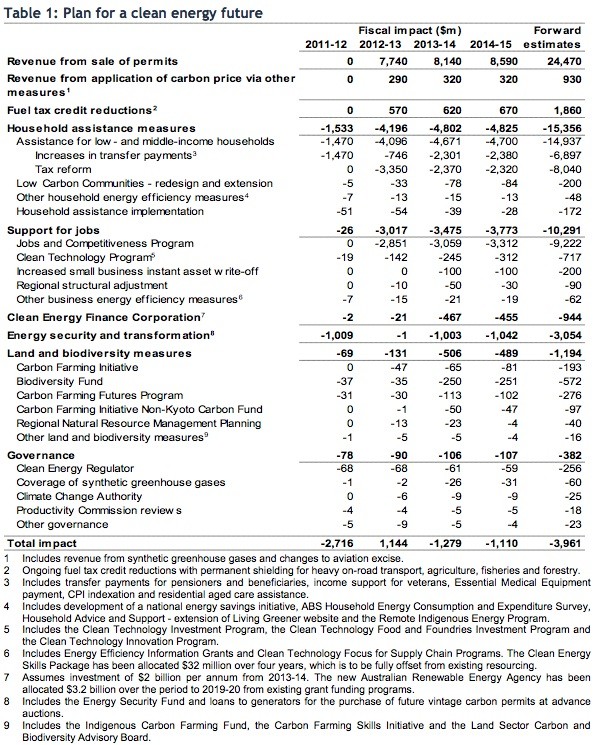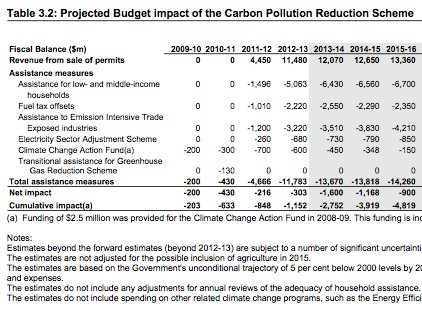The government has announced its “Clean Energy Future” package to commence from July 1, 2012.
Price:
- Carbon price of $23 a tonne starting July 1, 2012, rising by 2.5% in 2013-14 and 2014-15
- Floating price from July 1, 2015
- Price floor of $15 a tonne (indexed), ceiling of $20 above the expected international price (indexed).
Pollution target:
- 5% reduction by 2020 as default position, new target of 80% reduction by 2050
- First 5 years’ caps announced in 2014 budget, extended every year by one year
- Nine-member Climate Change Authority (headed by Bernie Fraser) to recommend caps and targets and advise on all aspects of the scheme
- First report February 2014, then every two years. Government required to explain why if it does not adopt CCA targets.
Coverage:
- Stationary energy, industrial processes, fugitive emissions, emissions from non-legacy waste
- Agriculture not covered, light commercial and household transport not covered
- Other transport to face reduced business fuel tax credits outside agriculture, aviation to face higher excise;
- PC to review fuel excise arrangements regarding emissions intensity
- International permit use not permitted until >2015; maximum of 50% of international permits can be used by an entity.
Expected economic impact:
- 0.7% CPI rise in 2012-13
- GDP growth reduced by >0.1% pa
- 10% increase in electricity prices in 2012-13.
Household compensation:
- Pension to rise by 1.7%
- Self-funded retirees to receive increase in Senior Supplement
- Family Tax Benefit to rise by 1.7%.
Tax cuts:
- Two-stage increase in the tax-free threshold from $6000 to $18,200 on July 1, 2012 and $19,400 in 2015-16 – tax cut of $300pa for incomes up to $68,000
- Matching adjustment to tax rates to increase second tier (30%) to 32.5% and then to 33%; other tier rates to remain the same; no one to face a tax increase as a result of tax changes
- One million people no longer have to lodge tax return.
Industry compensation:
- $9.2 billion in compensation
Emissions intensive trade exposed industries
- Under Jobs and to receive assistance on three tiers:
- 94.5% of free permits for industries with average baseline of a minimum 2,000t CO2-e/$m revenue or 6,000t CO2-e/$m value added
- 66% of free permits for industries with average baseline of a minimum 1,000t CO2-e/$m revenue or 3,000t CO2-e/$m value added
- 50% for LNG industry
- Assistance to be scaled back 1.3% pa
- Assistance to apply for at least six years
- Productivity Commission to review assistance in 2014-15 (or earlier if there is evidence of windfall gains) with the goal of assistance being wound back in 2018 to levels proposed by Garnaut Review if PC agrees
Steel Transformation Plan: $300 million for “innovation” in steel manufacturing (in addition to EITE assistance plus an additional allocation of free permits)
Coal Sector Jobs Package: $1.26 billion over six years to assist with emissions from gassy mines
Clean Technology Program: $1.2 billion to support low-emissions manufacturing
Energy Security Fund: to pay for closure of up to 2000MW of highly-emissions intensive generation capacity by 2020, provide $5.5 billion in free permits and cash to the sector to 2016-17, establish an Energy Security Council
Clean Energy Finance Corporation: to invest $10 billion over five years from 2013-14 in renewables and low emissions technologies (not Carbon Capture and Storage), run by an independent board
Australian Renewable Energy Agency to oversee $3.2b in renewables funding, in addition to any dividends from Clean Energy Finance Corporation
Fiscal impact:
- Revenue: $7.7-$8.6 billion pa to 2014-15
- Fuel tax savings: ~$600 million pa
- Household assistance: $4.1-$4.8 billion pa
- Industry compensation: $2.8-$3.3 billion pa
- Total impact: Additional cost to the budget (beyond scheme revenue) of $3.96 billion over four years including this year — spending to be accommodated within goal of return to surplus and 2% real spending cap.
Comparison with the final version of the CPRS:










Thanks Bernard.
I wonder if a detailed, acceptable, reasonable alternative carbon reduction policy exists? Does the LNP have one?